
Something is broken.
Maybe it's your workflow. Maybe it's how you collaborate across multiple teams. Maybe it's knowing how the content you produce influences ROI.
At CoSchedule, we know you'd like help to get organized... and to do that, you might need to pitch CoSchedule to your boss and to your team.
Whatever snag you're hitting as you manage your marketing team, chances are... something needs to change before it will get better.
And the best person to influence that change for the better is
you.
So the question becomes... how can you do it?
It takes some finesse with office relationships, psychology behind change management, and perseverance.
Let's explore how you can be
the marketing change management mastermind that not only starts the change you need, but also helps implement and sustain that change.
Get Your Marketing Change Management Timeline Template
Use the free spreadsheet that complements this blog post to plan your marketing change management strategy. You'll put everything you'll learn throughout this post into a plan you can execute.
You'll also get a marketing change management template in Word to help you communicate effectively with your manager, team, and stakeholders.
Go ahead. Download for free now!
Step 1: Create The Business Case For Change
Yeah, I know what you're thinking.
Ugh.
But.
Creating a doc to have one version of the truth—a reference point for questions—will help you convince your manager and team that change is needed.
There are three key points to address in your change management business case doc:
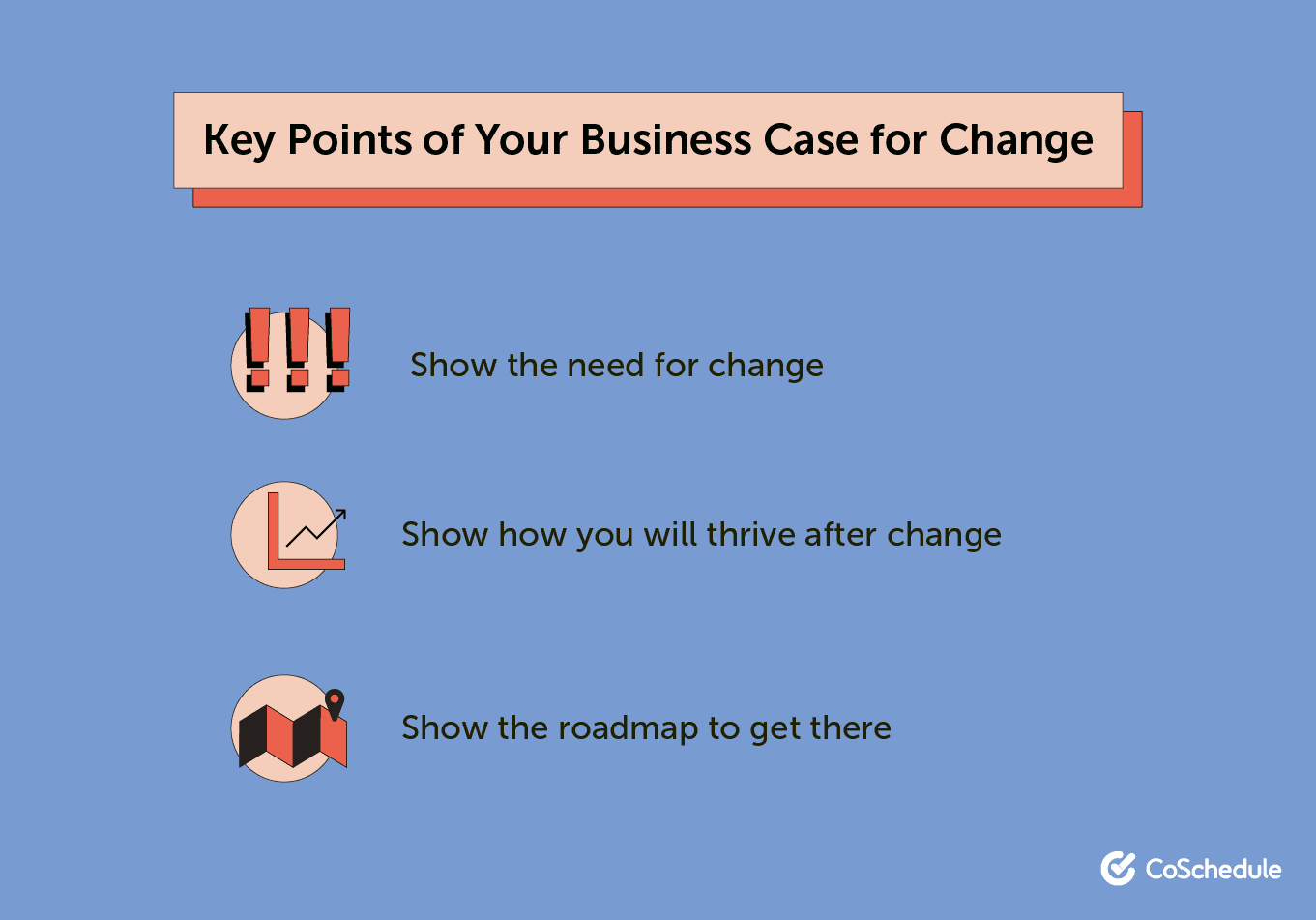
#1. Show There Is Need For A Change
You
feel when you need a change. There is disorganization. There are poor results. There are missing pieces.
The best way to
prove the need for change is with cold hard facts and brutal honesty. It's impossible to argue against factual information that informs your stakeholders
why the change is necessary.
There are a few ways to do this:
Data
Is what you're doing producing the results you expect?
For example, you may be spending a lot of time on trivial projects that don't actually produce repeatable, measurable results.
You could measure the hours you and your team spend on those projects in an average week. Then multiply the time by each employee's hourly wage to understand how much money the company literally spends on projects that
do not actually add anything to your bottom line.
If you add up those dollar values and multiply by 52, you literally know how much money goes down the drain in a year.
Use the Time Tracking tab in your change management template spreadsheet that complements this blog post to track the time + spend on tasks:

Think about how much time you spend:
- Switching in and out of tools not designed for the specific purpose you're using them for.
- Making edits to content that won't actually make a difference in the end results it will produce (shooting for perfection is extremely expensive).
- Getting approval after you create content (then reworking nearly everything).
With very simple math, you can demonstrate how expensive these activities are, thus showing the need for change.
Pro Tip: You can also use this method to show what you could be doing with your time that would generate bigger results. So, let's say you find that logging in and out of multiple tools + disorganization sucks up 4 hours of your week. Is that the same amount of time it would take you to write a blog post? There is proof: When we find a tool that is designed to help my team be more productive, we will write more blog posts which are proven to help us grow the business.
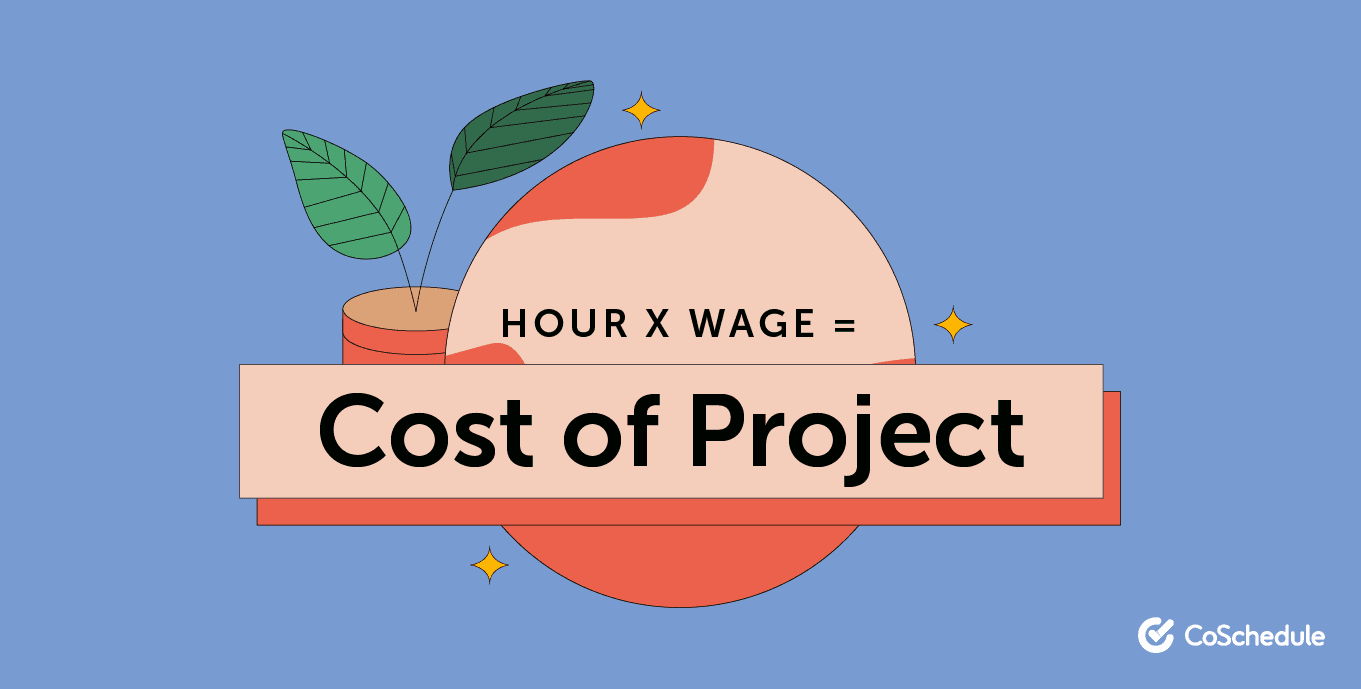
Another data example involves
analyzing the success of your best-performing content.
What if you focused more time shipping new projects that are similar to your existing top-performers?
From experience, I can tell you that you don't need to publish
more content, but the same amount of the
right content. And you could boost your results by 9,360%.
No joke.
Here is how to calculate this quickly,
or read this for an exhaustive, in-depth guide
- Set up goal tracking in Google Analytics and create a custom report to easily view the content that contributes to those goals. Here are in-depth instructions to help you do this in 5 minutes or less.
- Create a list of the last 30 pieces you published that are at least 30 days old. Use the Content Grading tab in your change management template to do this.
- Write down the amount each piece has contributed to your goal by using the Google Analytics custom report. To make this an even fight for each piece, I like to collect data from the first 30 days after publication, so every piece has an equal amount of time to contribute to your goal.
- Sort your content by your goal, peruse through those top-performing pieces, and write down the qualities you see repeated over and over. For example, at CoSchedule, the qualities we saw repeated over and over again were an interesting topic, well-researched and factual, comprehensive + actionable, keyword-driven, and optimized to convert traffic into email subscribers.
- Find the average goal contribution from every piece in your sample. If you continue the status quo, this is what you will continue to produce. Then find the average contribution from your top 10 pieces. It's way higher, right!? Now you know if you publish the same amount of content, and simply match the qualities from your top-performers, you will boost your results.
There you have it.
Proof that you need to pivot to increase your team's performance.
Examples
You might not have content that exists to help you prove you need to do more of what's already working. That's where examples come into play.
Examples are also proof, or evidence, of a need for change.
You can:
- Demonstrate a broken internal process by showing the inefficiencies of your current workflow. Again, inefficiency is expensive, and you could back this up with numbers using the process above. Examples: Workflows, approval processes, collaborating across multiple teams.
- Show an interesting use case with the new marketing idea from any other company. Then connect the dots to how you could do it for your business. Researching the data behind this makes your change management business case that much stronger. Example: You believe a blog would be great for your business, but you know there will be some resistance. Find examples of successful businesses that have built their credibility with a blog and are now multi-million dollar enterprises.
- Show how your competition is doing something amazing, but you don't have a presence in that area. This appeals to the fear of missing out, or FOMO. Example: You know your audience uses Instagram and would like to have a presence, but you're hitting some resistance. Find examples of your competition engaging with your audience on that channel as proof that your audience indeed uses that network to communicate with brands they love.
Industry Trends
If there is one thing that's constant, it's change. Especially in the marketing industry: New technology, new channels, and new ideas are ever-evolving.
This is similar to examples, but you can:
- Cite credible industry publications that cover new changes. Look for the why behind this: Why should you use the new tool, social media channel, or new content idea?
- Look for case studies that demonstrate the value of the trend. Has anyone (even outside of your niche) published a piece that shows percentage increases or demonstrates what you'll get out of the new idea?
You'll note, I led this section with more examples of finding
your own real data to prove why you need to change. Using your data as much as possible builds the strongest case for the change you'd like to implement.
It's hard to argue with
your facts versus how others have been successful.
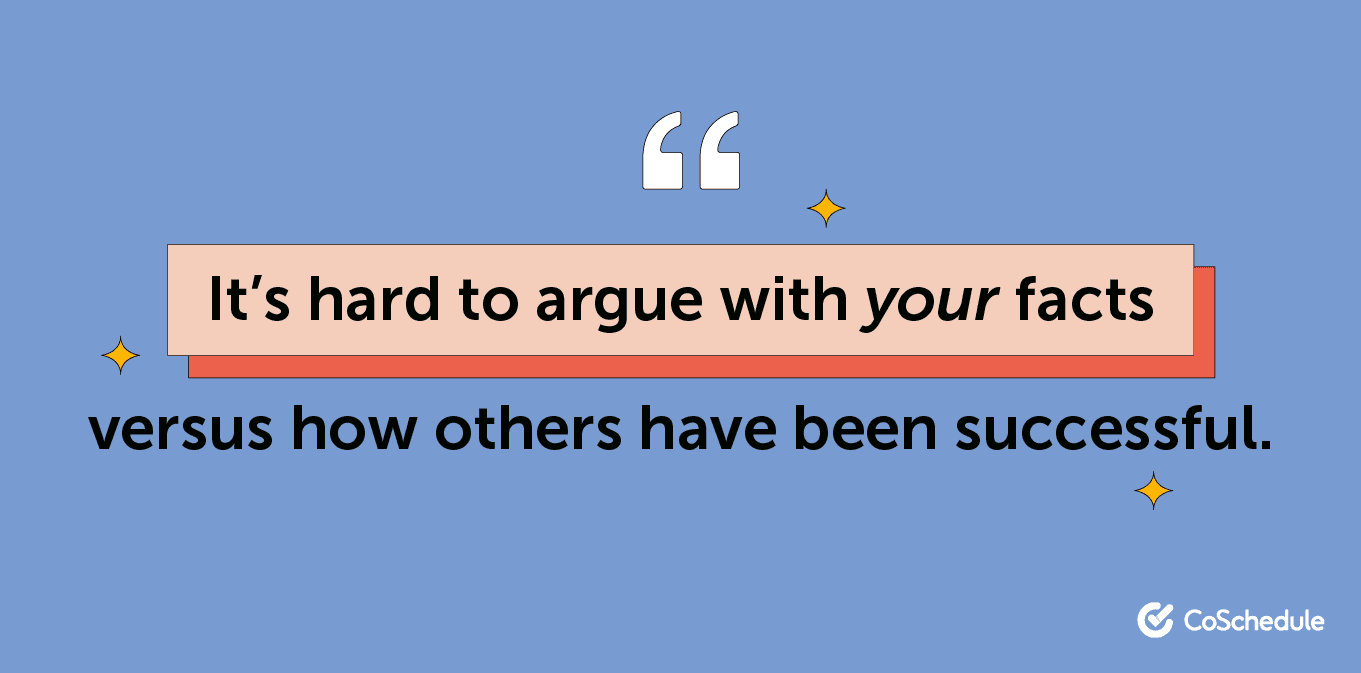
#2. Show How You Will Thrive After The Change
You've shown evidence that suggests change is necessary. Now it's time to demonstrate the benefits behind making the change.
An easy way to think about this is with a simple framework:
When we {do this}, we will {get this}.
Note
when there.
When demonstrates an inevitability whereas
if is only possible.
Let's look at an example here, using examples and data to prove the need for change + backing up how implementing that change will help
you produce bigger results.
The example is a broken process. I hear from marketing supervisors all the time that disorganized processes and "herding cats" sucks the most time away from their days, preventing them from focusing on the strategic work that would generate bigger results.
To prove the need for change, you:
Lay out the example of what the existing workflow looks like.
Leave no stone unturned: Every step, every person involved, every tool, every point of communication, and especially the parts that are broken.
For you, this could be writing a white paper. The workflow involves:
- Email: Gather the idea from the sales manager.
- Email: Determine who the subject matter expert is with the sales manager.
- Meeting: Interview with the sales team member who is a subject matter expert on the topic to gather the story.
- Email: Hound the sales team member to provide stats + facts to support the claims you'll make in the white paper.
- Google Docs: Write the "What's in it for me?" and outline.
- Email: Peer review the outline with the subject matter expert.
- Google Docs: Write the first draft.
- Email: Gather feedback on the first draft from the subject matter expert.
- Google Docs: Implement the feedback from the subject matter expert into the white paper.
- Email: Gather further feedback from the subject matter expert.
- InDesign: Design the white paper.
- Email: Gather further feedback from the subject matter expert.
- InDesign: Implement changes from subject matter expert.
- Email: Get approval from the sales manager.
- InDesign: Implement changes from sales manager.
- Email: Get approval from your manager.
- InDesign: Implement changes from your manager.
- Email: Give final draft to sales manager and your manager to distribute to internal staff.
If that even looks remotely like your workflow, there is definitely a better way.
Recommended Reading: How to Boost a Marketing Workflow Process That Will Reduce Work By 30-50%
By showing something like this, you demonstrate the
problem. Now you can show off the
solution.
When we cut several unnecessary approval steps, we will save my team 5 hours of productivity time every week. That's the same amount of time it takes to write a brand new white paper, which is proven to generate 150 marketing qualified leads when we write it like our top-performing white papers.
Therefore, when we don't change, we are literally wasting time on a broken process rather than focusing our time on generating bigger results. Here's how.
- Weekly Meeting: Gather the story from the sales manager and subject matter expert with clear action items for sales to provide stats on time saved from our solution + percentage increase on their desired goal by the end of the week.
- Google Docs (integrated into CoSchedule): Write the "What's in it for me?" and outline.
- CoSchedule: Peer review the outline with the subject matter expert.
- Google Docs: Write the first draft.
- CoSchedule: Gather feedback on the first draft from the subject matter expert.
- InDesign: Design the white paper.
- CoSchedule: Get approval from the sales manager + your manager.
- InDesign: Implement changes from sales manager + your manager.
- CoSchedule: Give the final draft to the sales manager and your manager to distribute to internal staff.
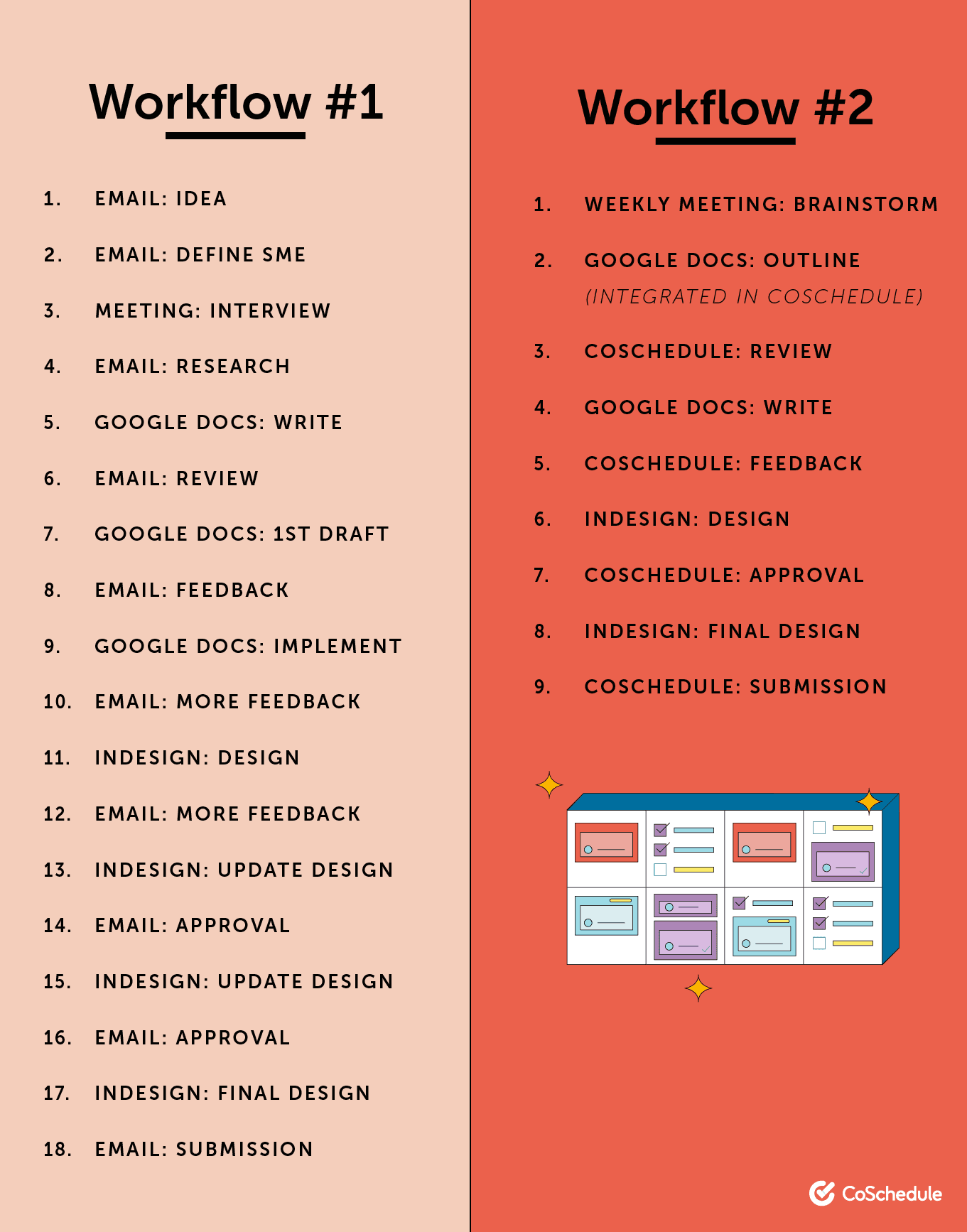
You just literally cut the amount of work in half, not to mention eliminating endless email strings that are super easy to miss.
Now you can track how long it would take for each step from the existing process and subtract the time saved from your new process. So all 18 tasks minus the 9 you removed would be the equivalent of 5 hours in this example. This doesn't even take into account the feeling of being organized, which everyone involved in the process will also love!
#3. Show The Roadmap To Get There
It's one thing to know what you need to do. Now you need to lay out the plan to implement the change.
Humans are naturally adverse to change, so the odds are this will not happen overnight. In fact, if you've been following an old process for a long period of time, it may take up to
21 days to help your team members build new habits.
Therefore, your roadmap to onboard your team members to learn this new behavior should span several weeks. In this time period, you will want to literally lay out your game plan schedule of what you'll do to make the change stick.
- Pre-rollout: Gather the data, examples, and industry trends demonstrating the need for change.
- Pre-rollout: Create your timeline for implementing the change.
- Pre-rollout: Script the questions, roadblocks, and objections that have potential to mitigate change.
- Pre-rollout: Discuss the forces driving change, timeline, and scripts with your manager.
- Day 1: All hands kickoff meeting. Your itinerary should cover the three things you've been learning about: The problem (what's wrong), the solution (why this change is necessary now), and the roadmap you're creating at this moment. You should also leave time for questions + answers (more on this to come).
- Day 2: Implement your team's initial feedback into the new solution.
- Day 3: Show your team that you took their advice and enhanced the new solution.
- Day 4: Remind your team to use the new solution.
- Day 5: Retro and iterate.
- Weekend
- Day 8: Ask your team informally how things are going. Instant message could work well. This reminds everyone (especially your most quiet team members) that they have a voice in the change process.
- Day 9: Implement the feedback into your process, and remind the team to use it and not retrogress to old behavior.
- Day 10:
- Day 11:
- Day 12: Retro and iterate.
- Weekend
- Day 15: Again, ask your team informally how things are going, and look for feedback.
- Day 16: Implement the feedback into your process, and remind the team to use it and not retrogress to old behavior.
- Day 17:
- Day 18:
- Day 19: Retro and iterate.
- Weekend
You can map out your game plan in CoSchedule, too, using a
Marketing Project. When you decide to use CoSchedule, everyone will see everything you're working on in one place... so why not add this into CoSchedule, too? ;)
Step 2: Be Prepared + Proactive For Any Situation
Bill Walsh was the head coach of the San Francisco 49ers, and helped turn a losing football team into one of the best, winning three Super Bowls.
Talk about change management.
Walsh is known for planning his plays for every scenario. He carefully planned exactly what play would work for specific situations like being 30 yards from the end zone with only 5 seconds on the clock. He's known for having planned the first several plays of the game whether the 49ers were kicking or receiving.
In short, Bill Walsh planned his work, then worked his plan.
He called this practice
scripting. And
it's a great framework you can apply to your change management, too:
“Scripting allowed me to take randomness and stress out of the decision-making process. The result is a very adaptable but intelligent plan for the future.” —Bill Walsh
Anticipate Questions
Uncertainty avoidance is the psychological term used to describe a specific society's tolerance for ambiguity.
While this term is generally used to describe larger cultures as a whole, your team and business have a culture within them, too. And the main idea here is that people like process, rules, and the same-old-same-old because it's familiar, easy to remember, and they already have habits that
literally help them do the work with less thought and effort than taking on something new.
Knowing this, you can plan on the questions your team will ask as you make the change. This is your script for an FAQ (or frequently asked questions) for your team.
Simply take 30 minutes to brainstorm all of the questions your team may ask, then write down the answers:
-
- Why this change?
- Why now?
- What do you expect from me now?
- How will we collaborate now?
- What aren't we doing anymore?
- What new things are we doing?
- How should I voice my feedback?
The point here is to think through the most common questions you can realistically expect your team and stakeholders to ask you, so you have all the answers prepared in advance.
You can use the change management Word doc template that complements this blog post to help you get started.
Recommended Reading: The Best 30 Minute Content Marketing Brainstorming Process
Anticipate Roadblocks
Again, change is often difficult for people to accept. Most people are satisfied with the status quo, in other words, doing exactly what they're doing now.
Back in 1947, psychologist Kurt Lewin researched this phenomenon and came up with the
force field analysis. Essentially, there are forces driving change while other forces restrain change, which makes it most comfortable for people to stay in the status quo.
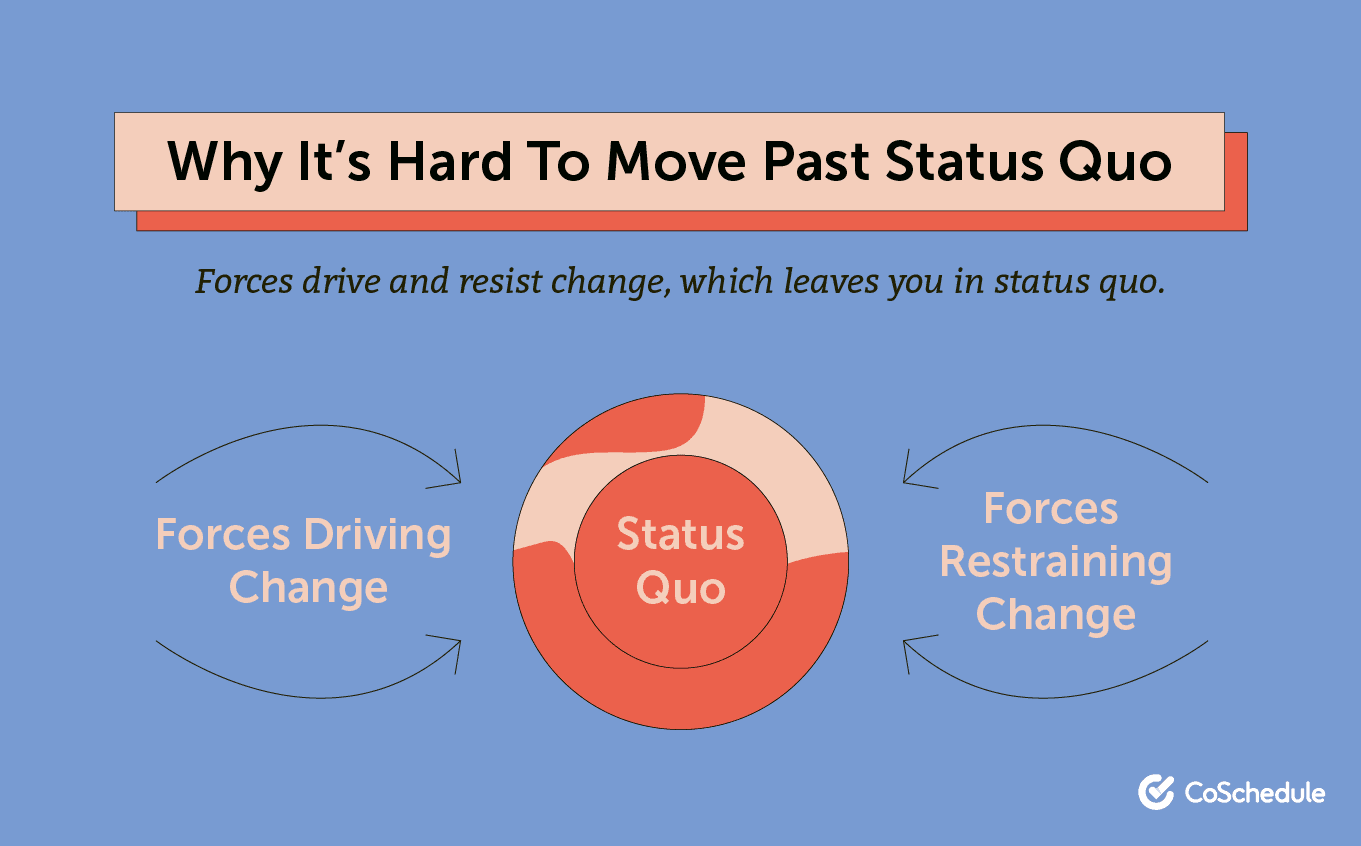
You are the force
driving change within your organization. So you should prepare for how you'll address the forces
resisting change:
- How will you phase out old, outdated tools you no longer need to use? What does the timeline look like?
- How will you onboard your team members to use the new tools as you expect? What does the timeline look like?
- How do you take into account everything else on your team's plate and the time it takes to learn new skills (100 hours per person)?
- What will you do if a team member does not adopt the new process from the get-go?
- What will you do if a team member tries the new process for a day, then regresses to their former behavior?
- How will you handle team members who actively fight against the new process and try to get other team members on their side?
- How will you agilely learn from your success and mistakes as your team implements change?
Like your FAQ, think through and
script the answers to these questions. When—or if—the situation arises, you've planned exactly how to get your change strategy back on track.
Anticipate Objections
Your own team may fight for the status quo without really knowing why. This could be a force resisting change, or once again, a few more scenarios to script for:
- I don't think this will work.
- I don't like the new process.
- This is taking even more time than before the change.
- We can't remove those steps from our workflow because of {insert excuse}.
Change is an emotional beast. The best thing to do,
according to change management pros, is to address these concerns with factual evidence backing up the need for change.
Step 3: Get Your Manager On Board
Those same change management pros suggest change is best instituted from the top-down.
So once you have your game plan, it's probably time to loop in your manager to get her on the same page as you (and to have your back if the forces of resistance get in the way of the forces driving change).
Set up an hourlong meeting your manager with the following agenda:
- 10 minutes: Explain the existing problem.
- 10 minutes: Show the evidence that the problem is a big one.
- 10 minutes: Show the roadmap you'll use to implement the change.
- 10 minutes: Show your proactive planning to address the forces of resistance.
- 10 minutes: Chat through how you'll communicate the change with your team (and get their feedback), next steps, concerns, and when you will roll out the change.
- 10 minutes: Lay out your action items to work through after the meeting is over.
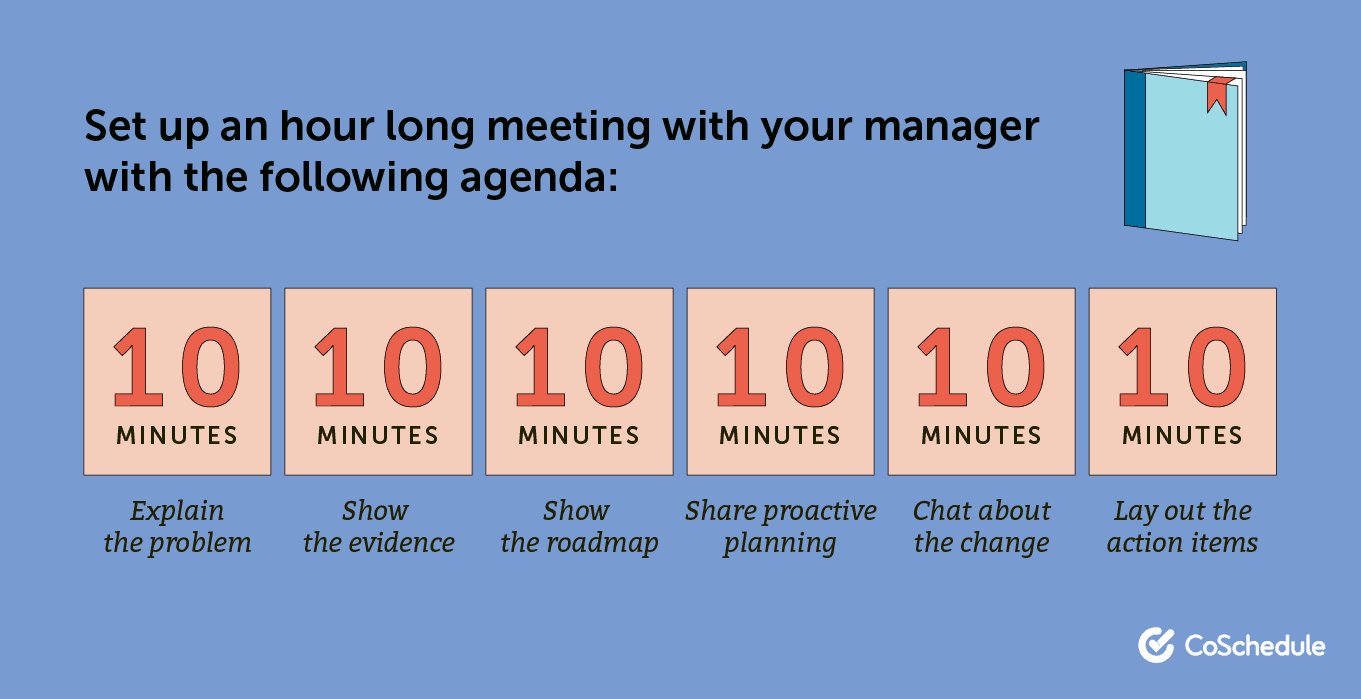
Those sections might feel a little long, but the point is for this to be a working meeting. Let your manager ask questions throughout, and show up ready to take notes so you can improve your marketing change management strategy based on her feedback.
What If Your Manager Doesn't Like The Suggested Change?
This is where you can use questions as a framework to understand how you can improve your pitch (or at least understand what the heck your manager is thinking):
- Why {do you believe that}?
- How {might you suggest I do that}?
If you're way off, schedule a second meeting with your manager (with the same agenda) to show her how you took her advice and will implement it in your strategy.
Recommended Reading: 38 Marketing Plan Samples And Everything You Need to Include In Your Strategy
Step 4: Involve The Team Early On
No one really likes to be told what to do. On the other hand,
involving your team members early and helping them
help you make the change decisions makes them feel like
they made them in the first place.
In their book,
Sprint: How To Solve Big Problems And Test New Ideas In Just Five Days, authors Jake Knapp, John Zeratsky, and Braden Kowitz suggest:
“By asking people for their input early in the process, you help them feel invested in the outcome. Later, when you begin executing your successful solutions, the experts you brought in will probably be among your biggest supporters.”
So... how can you involve your team + stakeholders early on?
Host A Process Change Kickoff Meeting With Everyone Involved In The Change
You pretty much have the itinerary from the chat with your manager (but make a couple optimizations here):
- 10 minutes: Explain the existing problem.
- 10 minutes: Show the evidence that the problem is a big one.
- 10 minutes: Show the roadmap you'll use to implement the change.
- 20 minutes: Give your team the chance to provide feedback right now, but also give them some time afterward to let the ideas percolate. This gives your quiet folks the chance to digest the information and provide thoughtful insight afterward. Beware of the psychological principle of conformity (and keep your loud team members in check).
- 10 minutes: Lay out your action items to work through after the meeting is over.
You also have all of that documented in your marketing change management template.
Recommended Reading: 86 Awesome Free Marketing Templates To Make Your Life Easier
Provide Time To Think Through Feedback
Give your team a deadline to provide their feedback and provide the method to do it (
email, instant message, etc.). You can plan this into your change management roadmap.
If anything, this keeps the process moving forward (and on a schedule) so you can fix what's broken quickly.
Incorporate Feedback Into Your Change Management Process
When you ask for feedback, you take it. That said, not all feedback will improve the plan.
The point is to literally help your team know and understand you are listening to them, that their thoughts are valuable, and you understand they will be the major players implementing the change.
So change the roadmap as needed and clearly communicate that you heard every idea and implemented many, but it just wasn't possible to include everything they requested.
Retro On What's Working, What's Not, And What You Could Improve
I'm borrowing this from agile product management practices. Every Friday, the marketing team at CoSchedule retros on the week, asking three questions:
- What went well? What should we continue doing?
- What went wrong? What should we stop doing?
- What could we improve?
Retros like this are great for gathering feedback from your team as you change their processes. I'd suggest hosting 15-minute retro meetings every week within your first 21 days specifically to discuss the change you're implementing to learn from your mistakes (and successes).
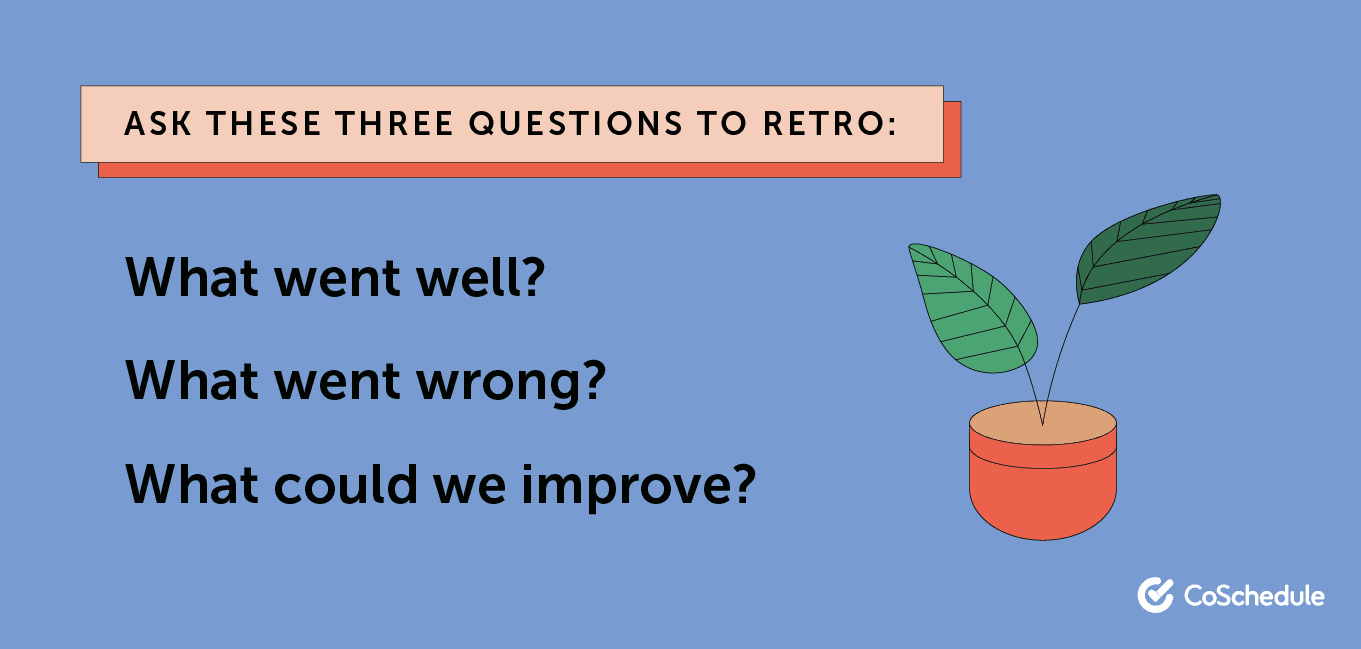
As feedback rolls in, you can use all of the work you put into writing scripts to great use!
Recommended Listening: How to Get Extremely Organized With Agile Marketing With Jeff Julian From Enterprise Marketer
Change of any kind requires breaking existing habits. And that is really difficult... because humans literally need habits to not think through the nitty-gritty details of everything in their lives (we would all go crazy).
So, to influence the right behavior,
the most important thing to do is to over-communicate with your team as they undergo change.
As
Bill Walsh said:
“We did the same drills over and over again; I said essentially the same thing over and over, discussed the same information, concepts, and principles over and over. Gradually, my teaching stuck.”
If it starts to become a joke that your team knows exactly what you're going to say next... you've done well.
The point is: When your team starts to think like you, they'll start to act like you.
And that's exactly what you want.
Which brings me to
leading by example.
Maintain zero tolerance for retrogressing behavior. If you see someone do something wrong, use your scripts to change the behavior and ask the following questions:
- What went wrong?
- Why did this happen?
- How can we make sure this doesn't happen again?
- How can we get this situation back on track?
The point of using questions like this as a framework is to let your team members answer them. They come up with their own solution for preventing unwanted behavior. And they know your thought process + expectations upfront.
There is no room in change management for being wishy-washy.
Finally,
commitment and perseverance influence change.
This process has the potential to feel messy.
Remember: You are the change management leader. You are responsible for planning your work, then working your plan. You are the one who will make this a reality.
You just need to do it.
How to Make Your Changes Stick
Whew! That was a lot (which also might be what your team members say when you start implementing changes).
This brings us to the next, and arguably most important, part of the change management process: making your changes stick. This takes just as much work, if not more, as implementing change in the first place, but is vital if you want to see the positive effects of your changes.
It all starts with forming habits.
How Habits Work (And Why It Matters)
Whether you're a manager or team member, your team's success is your success.
And that's where positive, team-based habits come in.
According to a
study in the
British Journal of General Practice, the wild world of healthcare shows us this.
“Furthermore, even when patients successfully initiate the recommended changes, the gains are often transient because few of the traditional behaviour change strategies have built-in mechanisms for maintenance.”
Unless positive changes become ingrained habits, achieving goals will become the exception rather than the rule.
That same psychological study defines habits this way:
"...actions that are triggered automatically in response to contextual cues that have been associated with their performance."
For a marketer, this habit loop might look like this…
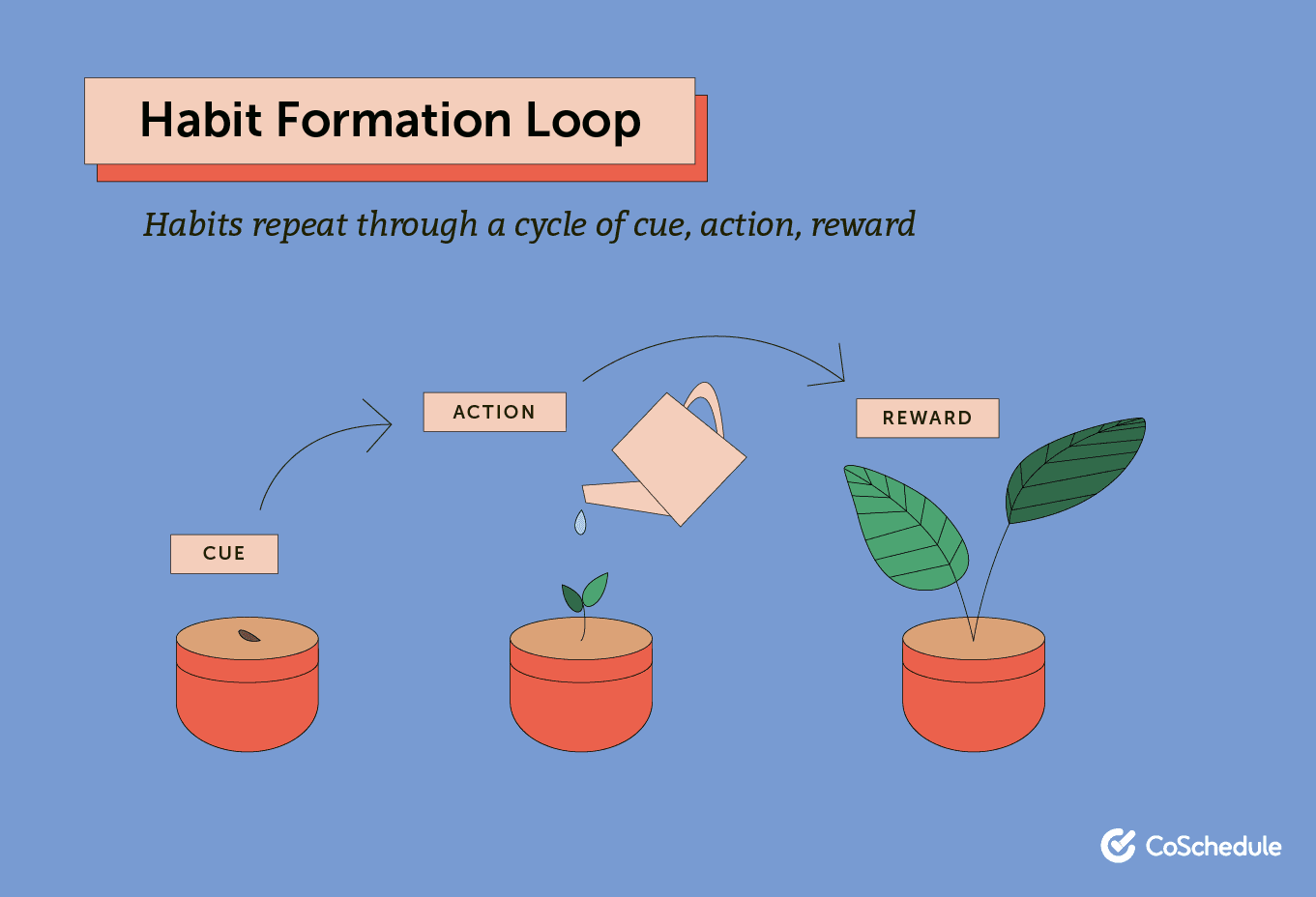
#2. Your Ingrained Action
So, be honest. What's your go-to action given the "contextual cue" of planning a new marketing campaign?
For tons of marketers, it's pulling out ye olde
spreadsheet!
Everything gets a tab. Everyone gets access on your internal drive or Dropbox account. And in short order, chaos ensues.

These are actual screenshots of spreadsheets, calendars, and systems CoSchedule customers have transitioned from over the years!
Here at CoSchedule, we call this a symptom of
makeshift marketing. Simply
defined, makeshift marketing happens when disconnected tools and apps are mashed into one
martech stack.
In our experience, this is one of the most difficult traps (and series of habits) to break for marketers.
But there's good news ahead!
This step is complete when your automatic action (read habit) is completed. Then, one more thing happens.
f#3. Your Reward
In his best-selling book,
The Power of Habit, author Charles Duhigg outlines a third piece to the habit puzzle: reward.
The reward reinforces the habit loop. With every completion, the habit gets more powerful.
In this case, the spreadsheet gives a sense of control, organization, and peace of mind.
The problem is that it quickly becomes messy. Often, you'll end up with spreadsheets to manage your spreadsheets!
Your Habits Become Your Team's Habits
The linchpin to sustaining changes in your organization, then, is leading the right habits...
...so you get the right results consistently.
Just imagine if your team smashed your marketing goals with the same frequency as brushing your teeth?
That's habit 101.
Let's talk about how to move from marketing mess... To marketing mastery.
According to
research at UCL Epidemiology and Public Health, it takes an average of
21 – 66 days to lock a
habit in place.
To help your team, I suggest this 3-step approach.
- Begin with your team's goal and reverse engineer actions to achieve it.
- Establish a rhythm of accountability.
- Build out *at least* a 21-day habit roadmap for your team.
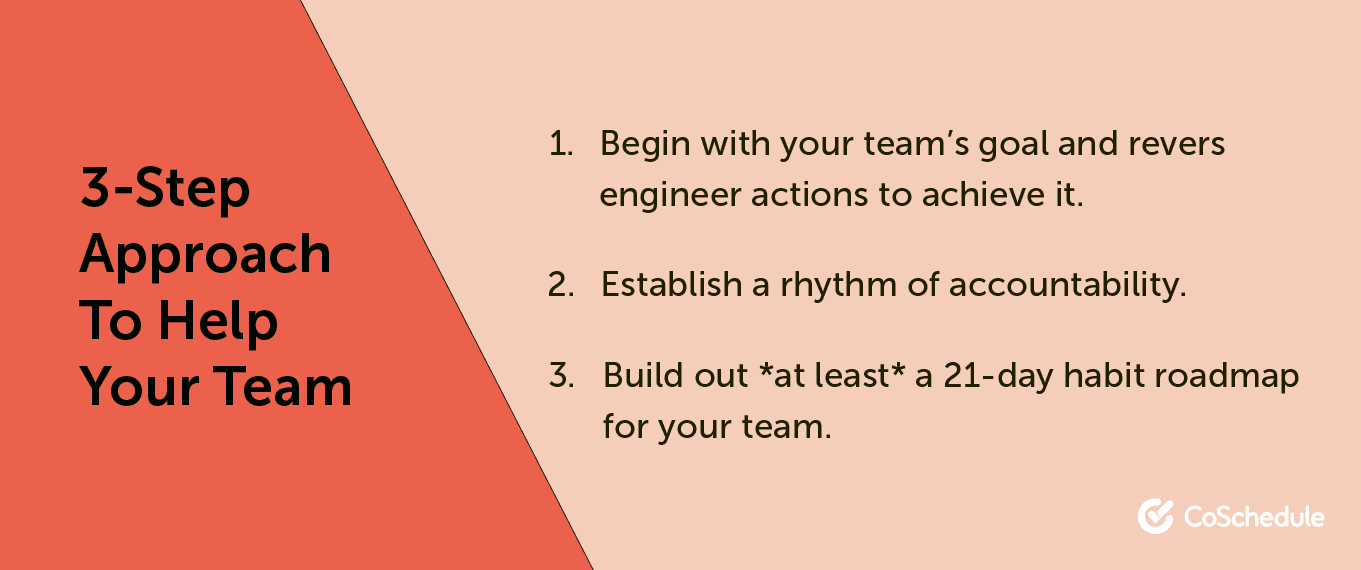
Step 1: Begin With Your Team's Goal
First things first, pull a
Stephen Covey...
"Begin with the end in mind."
Start with your team's goal (or goals). Then reverse engineer the consistent actions your team must habitually take to get there.
Here's an example of this anatomy as it would stand for publishing new content:
- Contextual cue: Your team publishes new content.
- Action: The creator of the piece streams a Facebook live video sharing a short TL;DR version and a CTA.
- Reward: More social media engagement + referral traffic.
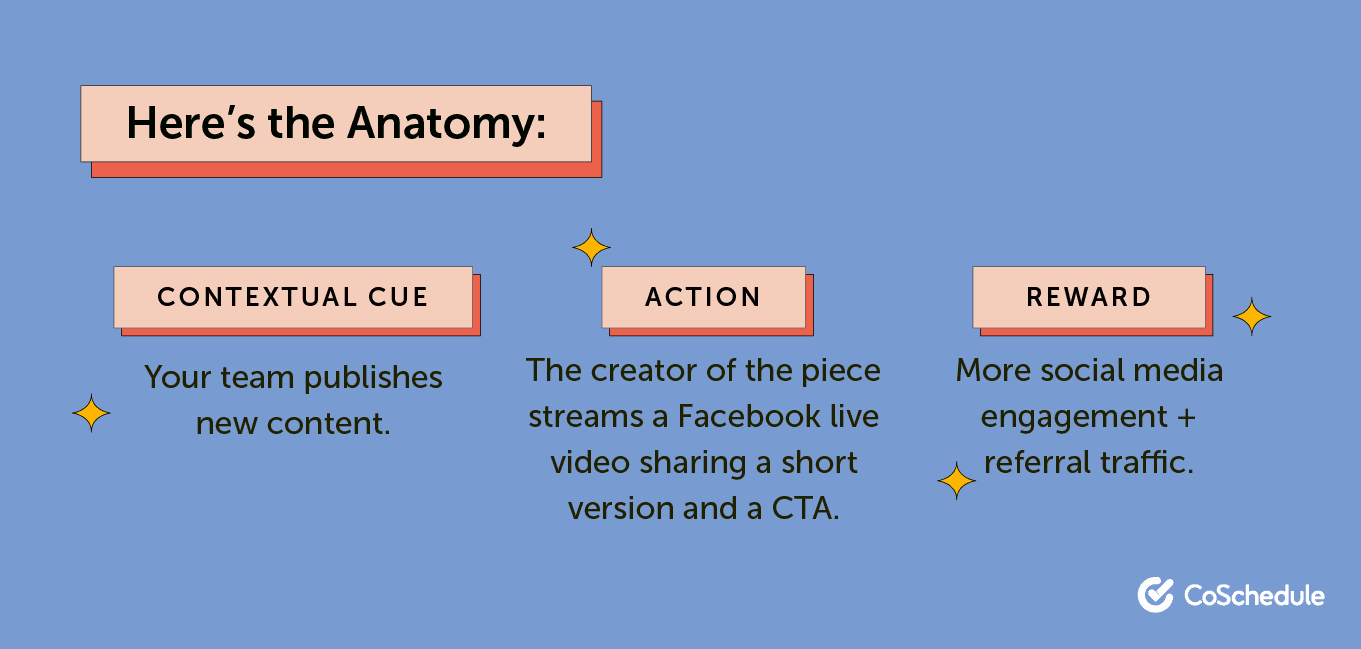
Next Step For Sustaining Change In Your Organization:
You might be wondering, "How is this different from simply adding an item to
your team's workflow?"
It's distinct because of its emphasis on ingraining a behavior versus checking a box.
For you, as the team leader,
leveraging the power of habits means automating behaviors.
When you put the
rightm thingson autopilot, they move themselves ahead with little (or no) friction.
Step 2: Build Accountability Into Your Team's Weekly Rhythm
Accountability gets a bad rap.
And that's because the threat of punishment is inherent.
If you're accountable for your actions, you're responsible for their outcomes.
There are a variety of
strategies to create accountability that help eliminate the fear of punishment.
But what if accountability could be more positive than negative?
It can. And it starts with ditching the word while leveraging the essence.
Accountability is about: clarity, alignment of actions with goals, and enablement of the right behaviors.
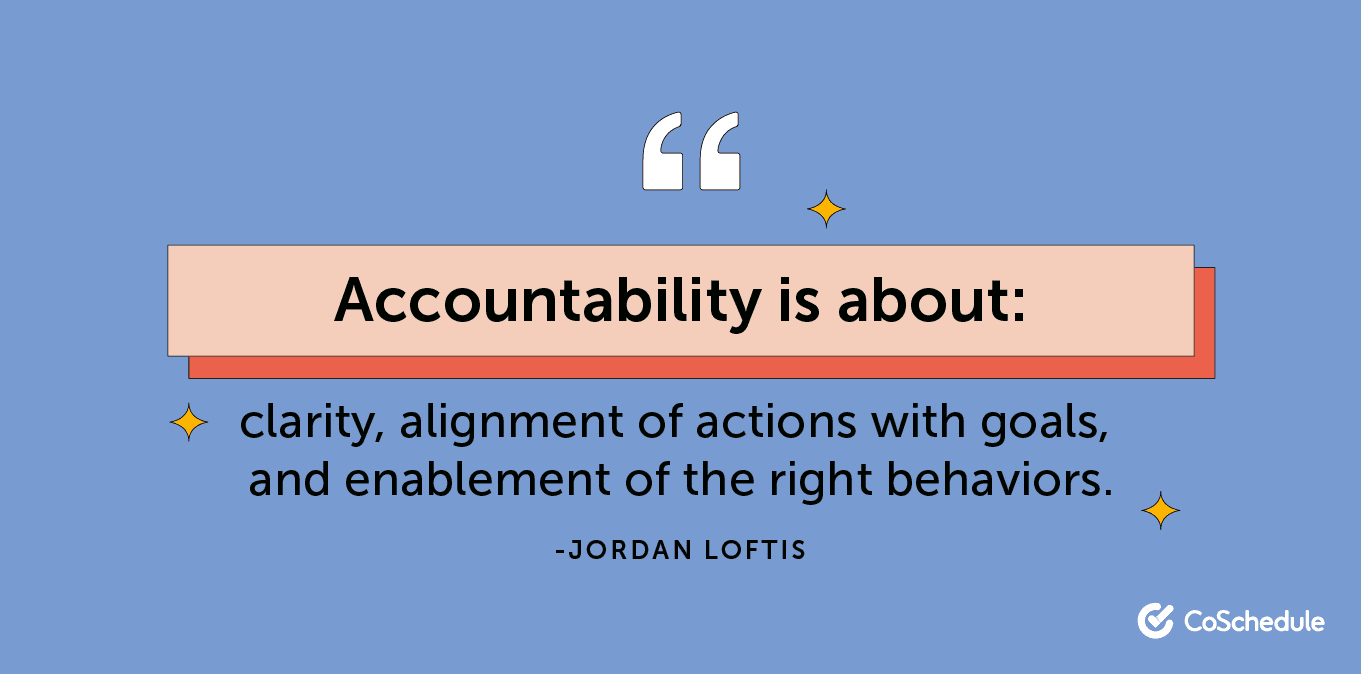
Sustaining Change In Your Organization With Clarity
Another alarming stat from the accountability study is:
"85% of survey participants indicated they weren't even sure what their organizations are trying to achieve..."
The quickest path to a homerun here is simple: be ultra clear with what results your team is after.
Is there one overarching goal you're hell bent on achieving?
Then talk about that. Every. Dang. Day.
Is there a long-term goal supported by smaller, short-term goals?
This is the case for nearly every team I've ever worked on.
If this is true, then keep your short-term goals in perspective. Help your team see how they accomplish your overall mission.
Sustaining Change In Your Organization With Alignment Of Actions And Goals
Now comes the supercharging power of habits.
By consistently performing the
right actions, your team will move the needle in the
right direction.
As you keep the mission in front of your team, help them understand the best actions to take them there.
One of the best places to do this is in your team meetings.
And you can begin by having everyone answer this simple question:
"If you could only do one thing every day to achieve [
team goal], what would it be?"
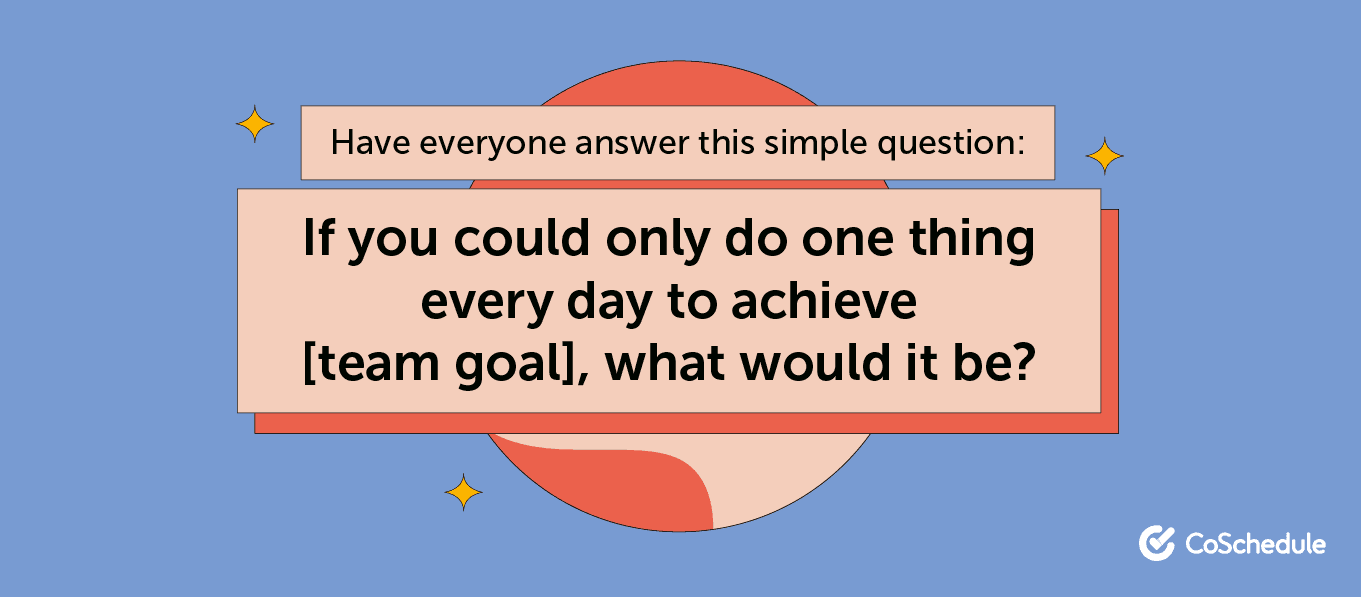
Have everyone answer the question.
Then, ask them to explain why that action is so powerful.
Sustaining Change In Your Organization By Enabling The Right Behaviors
And now, enable those positive behaviors with a third question:
"What roadblocks are there between you and consistently [taking desired action]?"
This is where you come in.
As a team leader, you should be an obstacle bulldozer.
It's tough enough to form new, positive habits.
(And break negative ones while you're at it.)
So clear the debris and get the crap out of the way.
Clear the clutter between your team and their most critical actions.
Then keep doing this.
Step 3: Build Your 21-Day Habits Roadmap For Your Team
To bring this all together, the best way forward is for you to get clear on what the next 21 working days should look like.
Scientifically, it takes anywhere from
18 to 254 days to establish a new habit, with the average being 66 days.
So, you can go for the hail mary and push your team for 66 days...
Or 100...
Or 254...
...if you'd like.
However, I suggest a quicker win: build a 21-day habits roadmap for your team.
In one of my favorite startup books,
Lean Analytics,
authors
Alistair Croll and
Benjamin Yoskovitz explain the rationale for setting goal metrics, saying:
"[I]f you want to change behavior, your metric must be tied to the behavioral change you want."
So focus the roadmap on the singular, most important behavior you'd like to download into each team member.
This can be super simple.
The key here is to show your team that you're committed to helping them build this habit just as much as they should be.
Create a
Projects Checklist.
Assign it to the right team member and set its completion date 21 days from now.
Then, assign the appropriate actions.
A clever way to start is by having each team member outline their own habit loop.
How will they ingrain this new high-value activity?
They should define a cue, routine, and reward.
Then, they should run through the habit loop
every day for the next 21 working days.
This might look like:
- A 21-day video promotion campaign,
- Logging into, and using, a new software tool every day (HUGE win for onboarding your team to new tools),
- Or even writing a fresh social post every single day.
Whatever it is, make sure you empower your team to make time each day.
What's Next For Sustaining Positive Changes In Your Organization?
To change results, you had to change behaviors.
To keep your results, you must sustain behaviors.
By using the biological superpower of habits, you can do this. To start:
- Begin with your team's goal, and make it ultra clear.
- Build accountability into your weekly rhythm.
- Empower your team to sustain change with a 21-day habits roadmap.
By following this roadmap, you can help push your team forward and form positive habits that will stick.
 Something is broken.
Maybe it's your workflow. Maybe it's how you collaborate across multiple teams. Maybe it's knowing how the content you produce influences ROI.
At CoSchedule, we know you'd like help to get organized... and to do that, you might need to pitch CoSchedule to your boss and to your team.
Whatever snag you're hitting as you manage your marketing team, chances are... something needs to change before it will get better.
And the best person to influence that change for the better is you.
So the question becomes... how can you do it?
It takes some finesse with office relationships, psychology behind change management, and perseverance.
Let's explore how you can be the marketing change management mastermind that not only starts the change you need, but also helps implement and sustain that change.
Something is broken.
Maybe it's your workflow. Maybe it's how you collaborate across multiple teams. Maybe it's knowing how the content you produce influences ROI.
At CoSchedule, we know you'd like help to get organized... and to do that, you might need to pitch CoSchedule to your boss and to your team.
Whatever snag you're hitting as you manage your marketing team, chances are... something needs to change before it will get better.
And the best person to influence that change for the better is you.
So the question becomes... how can you do it?
It takes some finesse with office relationships, psychology behind change management, and perseverance.
Let's explore how you can be the marketing change management mastermind that not only starts the change you need, but also helps implement and sustain that change.

 Think about how much time you spend:
Think about how much time you spend:
 Another data example involves analyzing the success of your best-performing content.
What if you focused more time shipping new projects that are similar to your existing top-performers?
From experience, I can tell you that you don't need to publish more content, but the same amount of the right content. And you could boost your results by 9,360%.
No joke.
Here is how to calculate this quickly, or read this for an exhaustive, in-depth guide
Another data example involves analyzing the success of your best-performing content.
What if you focused more time shipping new projects that are similar to your existing top-performers?
From experience, I can tell you that you don't need to publish more content, but the same amount of the right content. And you could boost your results by 9,360%.
No joke.
Here is how to calculate this quickly, or read this for an exhaustive, in-depth guide

 You just literally cut the amount of work in half, not to mention eliminating endless email strings that are super easy to miss.
Now you can track how long it would take for each step from the existing process and subtract the time saved from your new process. So all 18 tasks minus the 9 you removed would be the equivalent of 5 hours in this example. This doesn't even take into account the feeling of being organized, which everyone involved in the process will also love!
You just literally cut the amount of work in half, not to mention eliminating endless email strings that are super easy to miss.
Now you can track how long it would take for each step from the existing process and subtract the time saved from your new process. So all 18 tasks minus the 9 you removed would be the equivalent of 5 hours in this example. This doesn't even take into account the feeling of being organized, which everyone involved in the process will also love!
 You are the force driving change within your organization. So you should prepare for how you'll address the forces resisting change:
You are the force driving change within your organization. So you should prepare for how you'll address the forces resisting change:
 Those sections might feel a little long, but the point is for this to be a working meeting. Let your manager ask questions throughout, and show up ready to take notes so you can improve your marketing change management strategy based on her feedback.
Those sections might feel a little long, but the point is for this to be a working meeting. Let your manager ask questions throughout, and show up ready to take notes so you can improve your marketing change management strategy based on her feedback.
 As feedback rolls in, you can use all of the work you put into writing scripts to great use!
Recommended Listening: How to Get Extremely Organized With Agile Marketing With Jeff Julian From Enterprise Marketer
Change of any kind requires breaking existing habits. And that is really difficult... because humans literally need habits to not think through the nitty-gritty details of everything in their lives (we would all go crazy).
So, to influence the right behavior, the most important thing to do is to over-communicate with your team as they undergo change.
As Bill Walsh said:
“We did the same drills over and over again; I said essentially the same thing over and over, discussed the same information, concepts, and principles over and over. Gradually, my teaching stuck.”
If it starts to become a joke that your team knows exactly what you're going to say next... you've done well.
The point is: When your team starts to think like you, they'll start to act like you.
And that's exactly what you want.
Which brings me to leading by example.
Maintain zero tolerance for retrogressing behavior. If you see someone do something wrong, use your scripts to change the behavior and ask the following questions:
As feedback rolls in, you can use all of the work you put into writing scripts to great use!
Recommended Listening: How to Get Extremely Organized With Agile Marketing With Jeff Julian From Enterprise Marketer
Change of any kind requires breaking existing habits. And that is really difficult... because humans literally need habits to not think through the nitty-gritty details of everything in their lives (we would all go crazy).
So, to influence the right behavior, the most important thing to do is to over-communicate with your team as they undergo change.
As Bill Walsh said:
“We did the same drills over and over again; I said essentially the same thing over and over, discussed the same information, concepts, and principles over and over. Gradually, my teaching stuck.”
If it starts to become a joke that your team knows exactly what you're going to say next... you've done well.
The point is: When your team starts to think like you, they'll start to act like you.
And that's exactly what you want.
Which brings me to leading by example.
Maintain zero tolerance for retrogressing behavior. If you see someone do something wrong, use your scripts to change the behavior and ask the following questions:

 These are actual screenshots of spreadsheets, calendars, and systems CoSchedule customers have transitioned from over the years!
Here at CoSchedule, we call this a symptom of makeshift marketing. Simply defined, makeshift marketing happens when disconnected tools and apps are mashed into one martech stack.
In our experience, this is one of the most difficult traps (and series of habits) to break for marketers.
But there's good news ahead!
This step is complete when your automatic action (read habit) is completed. Then, one more thing happens.
These are actual screenshots of spreadsheets, calendars, and systems CoSchedule customers have transitioned from over the years!
Here at CoSchedule, we call this a symptom of makeshift marketing. Simply defined, makeshift marketing happens when disconnected tools and apps are mashed into one martech stack.
In our experience, this is one of the most difficult traps (and series of habits) to break for marketers.
But there's good news ahead!
This step is complete when your automatic action (read habit) is completed. Then, one more thing happens.


 Have everyone answer the question.
Then, ask them to explain why that action is so powerful.
Have everyone answer the question.
Then, ask them to explain why that action is so powerful.



